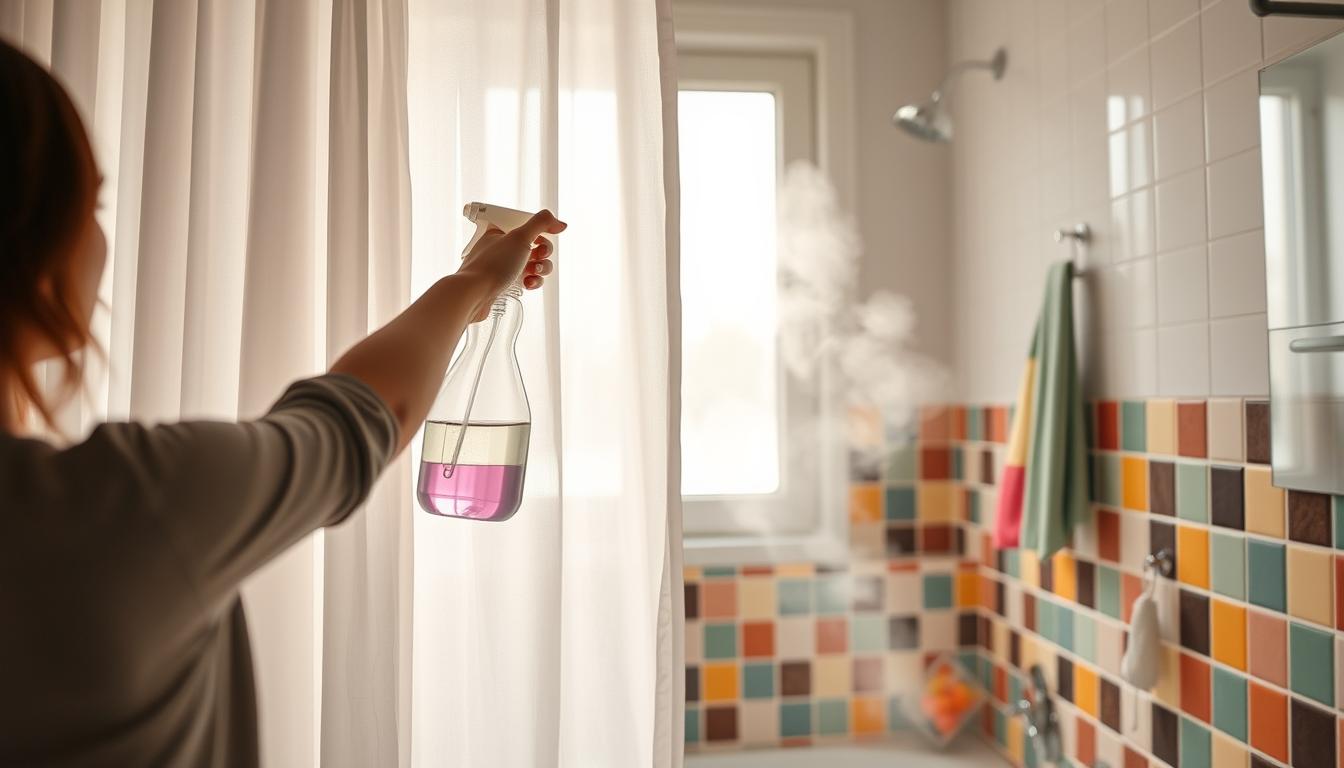Clean Shower Curtain Without Taking It Down
High moisture makes bathrooms germ hotspots. Shower curtains, close to toilets, can grow a lot of germs. The Cleveland Clinic says they need regular cleaning.
We’ll show you *how to clean a shower curtain without taking it down*. Our tips and natural solutions make it easy. You’ll save time and keep your bathroom looking good. No need to take the curtain down and put it back up. Our bathroom cleaning advice helps you keep your space clean and healthy with little effort.
Why You Should Clean Your Shower Curtain Regularly
Keeping your shower curtain clean is important for a hygienic bathroom. Regular shower curtain maintenance stops mildew, bacteria, and bad smells. This is not only about looking good but also about staying healthy.
Lauren Bowen from Two Maids & A Mop says to wash cloth curtains every three months. Liners need cleaning every month because they get dirty faster. This keeps your shower fresh and mildew-free.
To clean curtains well, mix vinegar with water. This mix gets rid of mold and soap scum. Spray it on, then rinse with warm water. Let it air dry after.
But don’t forget the rings and rod. Clean them weekly with vinegar. This stops mold and mildew on these parts too.
You can also wash most curtains and liners in the machine. Wash fabric ones on gentle with mild soap. Wash plastic ones in cold water with towels to stop wrinkles. Add baking soda and vinegar for more mildew protection.
- Wash cloth shower curtains every three months.
- Clean shower liners monthly.
- Use a vinegar-water solution for effective cleaning.
Following these steps will make your bathroom cleaner and healthier.
Essential Cleaning Supplies for Shower Curtains
Keeping your shower curtain clean is easy with the right products. You can choose between natural supplies or standard ones. It’s key to have all the right tools for the job.
Natural Cleaning Solutions
Using natural cleaners is good for the planet and effective. Items like vinegar and baking soda keep your curtain clean without bad chemicals.
Vinegar and Baking Soda
Vinegar and baking soda are great for freshening shower curtains. Vinegar fights mold and soap scum. Baking soda removes mildew and stains. Together, they clean your curtain safely without harsh chemicals.
Microfiber Towels and Buckets
Microfiber towels work well for scrubbing and drying. They are soft yet effective on shower curtains. Use buckets for soaking curtains in vinegar or for mixing natural cleaners with water. Having two curtains per bathroom means you always have a clean one ready.
How to Clean a Shower Curtain Without Taking It Down
Keeping a shower curtain clean doesn’t mean you have to remove it. Using a mix of vinegar and water works wonders. Vinegar breaks down grime and mold perfectly. Just mix vinegar and water equally in a spray bottle and cover the shower curtain with the mix.
Let the mix sit for 15 minutes to work on tough stains. Then, use a microfiber cloth or sponge to scrub. Whether it’s PVC, PEVA, vinyl, or nylon, this method is effective.
If stains are stubborn, mix baking soda with water to make a paste. Put this paste on the stains and wait 10 minutes before scrubbing off. This eco-friendly tip is among the best for removing shower curtain stains.
Rinse the curtain well with warm water to wash away any leftover cleaner. Let it air dry fully. Doing this weekly helps keep the curtain clean longer, reducing the need for deep cleaning.
These cleaning tips make keeping your bathroom clean easier. Regular cleaning is vital, according to the Cleveland Clinic, especially because shower curtains can harbor bacteria.
To fight mold and mildew, spray vinegar and water on the curtain often. This keeps your shower curtain looking new without using harsh chemicals or a lot of effort.
Step-by-Step Guide: Cleaning Cloth vs. Plastic Shower Curtains
Keeping your shower curtain clean is key to a hygienic bathroom. This guide covers how to clean your shower curtain, cloth or plastic, without removing it. With the right cleaning tips and products, you can keep your curtain fresh and free of bacteria.
Cleaning Cloth Shower Curtains
Cleaning cloth curtains is easy with household items. Just follow these simple steps:
- Check Care Instructions: First, look at the care label to see if it’s safe to machine wash your curtain.
- Pre-Treat Stains: Make a mix of 2 parts hydrogen peroxide with 1 part water to tackle mold or mildew.
- Machine Wash: Wash the curtain with mild detergent, adding ¼ cup white vinegar or baking soda. Use the gentle cycle to avoid damage.
- Drying: Hang the curtain to air dry. To speed up drying, you can use wool dryer balls. Add essential oils for a nice smell.
Wash your cloth curtain 4-5 times a year for the best results. This keeps mold away, a common problem in moist bathrooms.
Cleaning Plastic Shower Curtains
Cleaning plastic shower curtains is straightforward too. Here’s what you do:
- Pre-Treat New Curtains: Soak new curtains in a mix with ¼ cup of white vinegar. This helps prevent mold.
- Hand Wash: Spray the curtain with a vinegar mix or an all-purpose cleaner. Then wipe it down well.
- Machine Wash: You can also machine wash with ¼ cup of vinegar or baking soda. Throw in towels to help clean and avoid wrinkles.
To prevent dirt buildup, wipe your curtain weekly with a cleaner. This keeps it clean longer and reduces deep cleans to every three months.
For more tips on shower curtain care, visit Real Simple’s guide. Cloth and plastic shower curtains are often made to resist mold and germs, especially synthetic ones. Knowing how to clean them right keeps your shower clean and healthy.
Preventing Mold and Mildew on Shower Curtains
Keeping your shower curtain free of mold and mildew makes your bathroom healthier. Good shower curtain maintenance stops mold and mildew. It needs a few simple steps.
Start by washing your shower curtain, liner, rings, and rod every month. This stops mold and mildew from growing. Also, spray the liner with bathroom cleaner weekly to keep it clean.
Drying your curtain and liner right after use is key. Maeve Richmond, Maeve’s Method founder, suggests a tip. Keep the liner inside the tub, and the outer curtain outside. This helps them dry quicker and stops mold. Learn more about mildew removal from showers with home remedies.
Controlling humidity is important too. Keep bathroom humidity between 35% and 50% to fight mildew. Dry the shower’s inside with a squeegee after each use. It really helps prevent curtain mold.
For hard mold spots, try hydrogen peroxide or baking soda. They’re good at killing mold. Doing these things regularly keeps mold away and your bathroom clean and healthy.
Replace shower curtains that are badly stained, torn, or old every year. Staying on track with these tips helps a lot. It keeps your mildew removal from shower curtains easy, leaving your curtain looking good.
Clean, dry, and maintain your shower curtain well to avoid mold. This ensures a clean and healthy shower area.
Best Practices for Maintaining a Fresh Shower Curtain
Keeping your shower curtain in great shape is easy. Just follow a few simple steps. Make sure to clean it regularly, about once a month.
Marla Mock, who leads Molly Maid, suggests having two shower curtains for each bathroom. This makes it easy to switch them out. You can change the style of your bathroom with the seasons or as you wish by rotating the curtains monthly.
For cleaning plastic shower curtains, here’s a simple trick. Just add a bit of color-safe bleach, detergent, vinegar, or baking soda to your wash on a cool setting. Throw in a bath towel too. It helps balance the washing machine and gets rid of grime. Fabric curtains, however, should be spun dry and then hung to air dry.
Natural cleaning methods are great too. Try mixing water and distilled white vinegar in equal parts. Spray it on your curtain daily to fight soap scum. A bit of lemon oil can cover up the smell of vinegar. Once a week, use this mix on the curtain’s bottom and scrub to remove buildup.
The table below shows quick tips for keeping your shower curtain fresh:
| Key Practice | Details |
|---|---|
| Washing Frequency | Once a month |
| Rotation Strategy | Have at least two curtains per bathroom and rotate them monthly |
| Plastic Shower Curtain Cleaning | Add half a cup of color-safe bleach, detergent, vinegar, or baking soda to the washing cycle on cool; add a bath towel for balance |
| Fabric Shower Curtain Cleaning | Run through spin cycle, then hang to dry; avoid using a dryer |
| Daily Maintenance | Spray with a mixture of half water and half distilled white vinegar, add lemon oil for fragrance |
| Weekly Deep Clean | Spray the bottom with vinegar solution and scrub to remove buildup |
| Recommended Products | Arm & Hammer Baking Soda, Lucy’s Distilled White Vinegar, Hula Home Continuous Spray Bottle, Dirty Labs Bio Enzyme Laundry Booster, Outlines Shower Liner System |
These best practices make keeping your shower curtain fresh easy. They ensure your bathroom looks and smells clean. Try these tips to make your curtain last longer and your space more welcoming.
When to Consider Replacing Your Shower Curtain
Even if you clean your shower curtain often, there comes a time when you need to replace it. Keeping it in good shape is key to a nice-looking and clean bathroom. It helps make your bathroom look and feel great.
When your curtain gets damaged, it’s time for a new one. Things like rips, tears, or fraying edges make it look bad and less effective. If cleaning doesn’t get rid of mold or mildew, you should replace it. This is not only for looks but for health reasons too.
If your shower curtain doesn’t fit your bathroom’s look anymore, think about getting a new one. This is especially true after remodeling your bathroom. A curtain that doesn’t match can take away from the beauty of your space. Updating your curtain helps keep your bathroom looking fresh.
Experts say you should get a new shower curtain every six months to a year. Whether it’s fabric or plastic, curtains can get dirty and grow mildew. Replacing them regularly keeps your bathroom clean. Paying attention to your curtain’s condition helps keep your bathroom welcoming.

Hey there, I’m Alex Hanson and I’m passionate about all things covers! Whether you’re looking for a car seat cover to protect your vehicle or an oven cover to keep your kitchen clean, I’m here to help. With years of experience in the industry, I have plenty of knowledge and insights to share with my readers. So, if you care about protecting your belongings and making them look their best, you’re encouraged to read my blog as I explore the perfect cover for every need.







